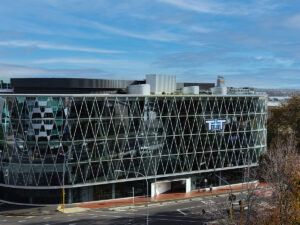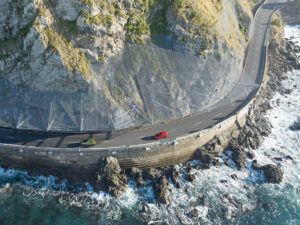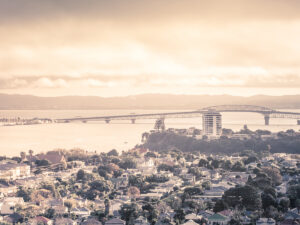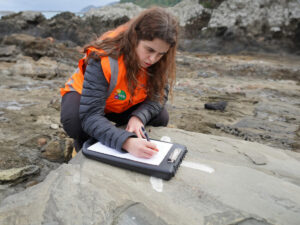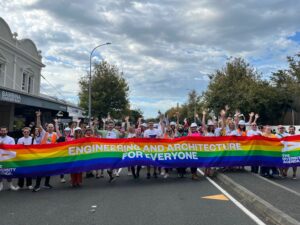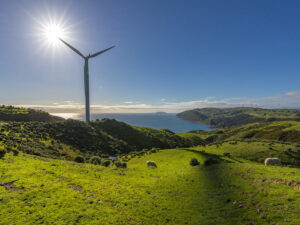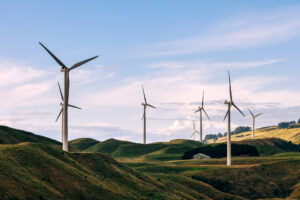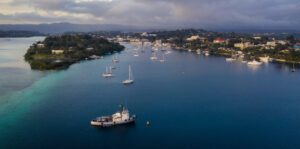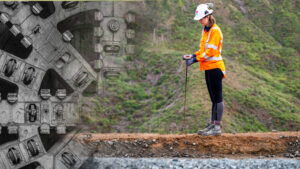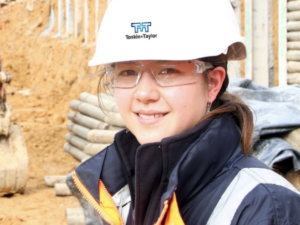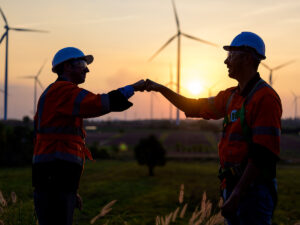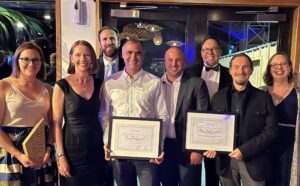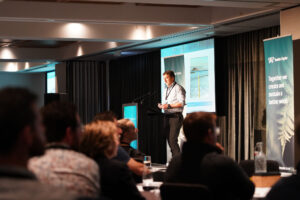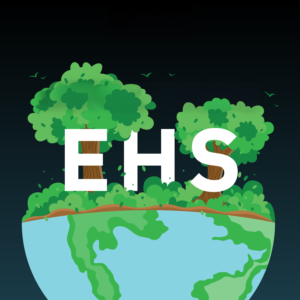Is New Zealand Ready for Recycled Drinking Water?
Access to clean drinking water is a necessity, and with a decline in freshwater availability, many parts of the world are safely reusing treated wastewater as a solution. Councils across Aotearoa have started considering potable reuse as an option, but are we ready for it? And can we do it safely?
We spoke to Tonkin + Taylor Principal Environmental Consultant Heather Uwins-England about her paper on potable reuse in New Zealand, presented at the 2024 Water New Zealand Conference.

Pictured left to right: Kumeroa Pihama, Pou Whanake – Technical Director Māori, Rob Van de Munckhof, Principal Environmental Engineer, Lisa Dowson, Senior Water Resources Consultant, Ben Senior, Water Resources Engineer, Dr Heather Uwins-England, Principal Environmental Consultant (Presenter), Chris Shanks, Discipline Manager – Integrated Environmental Management, Kenneth Macdonald, Kenneth MacDonald, Sector Director – Water
Running out of water
The 2020 COVID-19 pandemic, which isolated people worldwide, was not the only issue Tāmaki Makaurau residents faced that year. In June, already stressed Aucklanders battled a critical water shortage in New Zealand’s largest city – the worst drought in 25 years.
Climate change forecasts suggest this isn’t an isolated incident and will become a frequent issue in years to come. We need to diversify our water resources, and one option that arises is potable reuse of wastewater – but can it be done safely and is Aotearoa ready to embrace it?
Water reuse – what are the drivers?
Historically, New Zealand has had an abundance of fresh water, but there are a few key reasons that are leading to a need to diversify our water sources:
- Water scarcity – warmer and drier summers increase the likelihood of water shortages in urban areas
- Environmental concerns – increasing pressure on freshwater resources and ecosystems as the population grows
- Sustainability needs – As New Zealand aims to develop more sustainable practices across sectors, water management is top of mind
- Climate change resilience – climate models predicting more frequent and severe droughts in some regions
- Aging water infrastructure – urban areas in New Zealand are facing challenges with aging water infrastructure. As we undertake improvements to wastewater infrastructure to improve water quality we should be thinking about the potential uses of this treated water.

Can potable reuse save the day?
These drivers raise a big question: Is it time to consider treated wastewater as a potential drinking water source rather than a waste product to dispose of? Enter potable water reuse, the recycling of wastewater for drinking water purposes, treated using advanced technologies to produce high-quality drinking water, which can directly or indirectly enhance a supply.
Indirect potable reuse refers to water blended with drinking water sources like rivers, reservoirs, lakes or groundwater before being used for drinking water treatment. Direct potable reuse refers to treated water introduced directly into a drinking water supply system or just upstream of a drinking water treatment plant.
Australia, Singapore, the USA, and Europe have already successfully used potable reuse schemes.
Australia
Several Australian cities practice indirect potable reuse, where treated wastewater is discharged into rivers or aquifers before being retreated for drinking water.
Our Pacific neighbour has developed guidelines and regulations for water recycling, including the Australian Drinking Water Quality Guidelines which set limits for contaminants in recycled water used for drinking. They continue to discuss and research the potential for potable water reuse (and the possibility of direct potable reuse).
Singapore
Singapore is a global leader in water recycling and reuse with over a third of Singapore’s water supply coming from recycled wastewater. Singapore has implemented large-scale potable reuse through its NEWater program, which produces high-quality reclaimed water for both non-potable and indirect potable use.
Singapore lacks natural water resources and has limited space for water collection and storage. Recycling wastewater is part of its strategy to increase self-sufficiency and reduce reliance on imported water from Malaysia. There were challenges in public acceptance of drinking recycled water, however, through widespread education and campaigns, Singaporeans have come to embrace recycled water as an essential water source.
USA
Potable reuse is gaining traction in the United States as a viable solution to address water scarcity issues, particularly in areas facing drought, population growth, and climate change impacts.
The United States Environmental Protection Agency (USEPA) has published guidelines and resources on water reuse and regulation of potable reuse, handled at the state level. Several states have developed their own regulations and guidelines for potable reuse.
Colorado made history by adopting direct potable reuse (DPR) regulations in January 2023, becoming the first state to do so. California passed new DPR regulations in December 2023, setting comprehensive standards for converting wastewater into drinking water.
What’s stopping Aotearoa from taking this approach?
There are a few hurdles to the adoption of potable reuse in New Zealand:
- Public perception and acceptance
- Cultural considerations
- Lack of expertise in water reuse
- Regulatory framework
Public perception and acceptance: “The Yuck Factor”
Like in Singapore and the USA, Public perception and acceptance are likely to be a challenge, due to the psychological barrier known as the “yuck factor.” The “yuck factor” refers to the instinctive disgust or revulsion people may feel towards the idea of drinking water that was once wastewater, regardless of how thoroughly it has been treated.
Cultural Considerations
Māori cultural concepts and beliefs will also play a big role in the implementation of potable reuse in Aotearoa. For Māori, water is not just a resource but holds deep spiritual and cultural significance. Traditional Māori concepts and beliefs significantly influence their perspective on wastewater management and reuse, potentially with a view that potable reuse is an unsuitable approach.
Lack of Expertise
Another hurdle we face is New Zealand’s limited experience with advanced water reuse technologies and practices and a mature water quality safety culture. Historically, the main form of water reuse in New Zealand is wastewater for irrigation, as a means of wastewater discharge rather than true reuse. Moving from the current limited reuse practices to establishing potable reuse schemes requires a big leap forward.
Regulatory Framework
Lastly, New Zealand currently lacks a comprehensive regulatory framework to support the safe implementation of potable reuse schemes. The existing Water Services Act 2021, Drinking Water Quality Assurance Rules, and Drinking Water Standards are insufficient for addressing the unique challenges posed by wastewater as a drinking water source, as they do not consider treated wastewater as a potential drinking water source and lack specific guidelines for its management and quality control.
So, what next for potable reuse?
While New Zealand is not currently prepared to introduce potable reuse schemes safely and consistently across the country, there are clear pathways for progress.
To move forward, New Zealand needs to develop a comprehensive national strategy for wastewater reuse. This should include updating the regulatory framework, conducting public education campaigns, addressing cultural considerations, investing in treatment technologies, and building workforce capacity. Pilot projects, infrastructure upgrades, and ongoing research into potential long-term health impacts will be important steps in this process.
Specific guidelines and standards for potable reuse are readily available from the World Health Organisation – it’s not a matter of starting from scratch. With time and effort, these could be reviewed in the New Zealand context and incorporated into the New Zealand drinking water regulatory framework.
Trust in governmental agencies related to environmental control and quality plays a crucial role in addressing the ‘yuck’ factor. Water management authorities need to develop long-term public engagement strategies with a focus on building trust, providing clear and transparent information about treatment processes and water quality, and addressing specific concerns raised by communities.
Cultural considerations, particularly Māori perspectives on water and wastewater, require careful attention and engagement to ensure respect for traditional values and beliefs. To address these cultural concerns, early and meaningful engagement with iwi is a must.
By learning from international examples, New Zealand can develop a tailored approach to potable reuse that addresses its unique environmental, cultural, and regulatory landscape.
With careful planning and implementation, potable reuse could become an important part of New Zealand’s future water management strategy, enhancing water security and sustainability in the face of growing environmental challenges.
Sustainability at Tonkin + Taylor
For Tonkin + Taylor Group, sustainability is about making good choices that are critical to the long‑term future of our planet and people. We define sustainability as: actively responding to local and global, social and environmental challenges, the natural environment is truly valued and protected while shaping a future in which people and places are thriving, and all people are healthy, fulfilled, and empowered to pursue their aspirations.
Read more about our projects on water infrastructure and treatment services


